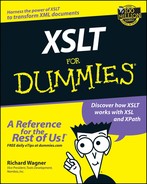Book Description
Restructuring information in an XML document so that it works in other formats used to be a time-consuming ordeal involving lots of blood, sweat, and tears. Now XSLT (Extensible Stylesheet Language Transformations) makes the process nearly instantaneous. Just provide an example of the kind of information you'd like to see, and XSLT does the rest. With XSLT you can effortlessly transform XML documents into virtually any kind of output, including other XML documents and HTML pages. But mastering XSLT can be tricky, especially if you've never worked with XML or HTML; and most books on the subject are written for people who have. Here comes XSLT For Dummies to the rescue!
XSLT For Dummies is your ticket to quickly mastering XSLT—no matter what your prior programming experience. Writing in easygoing, plain English, XML pro Richard Wagner provides expert advice, step-by-step guidance, and tons of crystal-clear examples to help you harness the power of XSLT to transform documen ts. In no time you'll:
Understand how XSLT works with XSL and XPath
Experiment with templates, stylesheets, and expressions
Perform HTML transformations
Master XPath data types and functions
Combine XSLT stylesheets
Explore cool XSLT programming tricks
XSLT For Dummies works from the ground up, starting with a practical introduction of the "X-Team"—XML, XSL, XSLT, and X-Path—and instructions on how to write a XSLT stylesheet. From there it quickly moves onward and upward through the whole range of important XSLT topics, including:
Transforming with stylesheets
Understanding and using template rules
Using XPath to locate nodes in XML documents
Combining XSLT stylesheets and adding processing instructions
Debugging XSLT transformations
Ten XSLT processors available online
It doesn't matter whether you're a babe in the woods who can't tell a "tag" from an element, or you're an old pro at creating XML documents, XSLT For Dummies offers you a fun, easy way to explore and take full advantage of Extensible Stylesheet Language Transformations.
Table of Contents
- Title
- Contents
- Introduction
- Part I : Getting Started with XSLT
- Chapter 1: Introducing the X-Team
- Chapter 2: Writing Your First XSLT Stylesheet
- Part II : Becoming an XSLT Transformer
- Chapter 3: Transforming with Style (Stylesheets, That Is)
- Chapter 4: Templates Rule!
- Chapter 5: XPath Espresso
- Chapter 6: We Want Results!
- XSLT, Like Skinning a Cat
- XML Source
- Copying an Element
- Copying All Elements
- Adding a New Element
- Adding a Calculated Value
- Renaming an Element
- Removing an Element
- Removing an Attribute
- Reordering Elements
- Merging Elements
- Adding Attributes
- Moving an Attribute
- Converting Elements into Attributes
- Converting Attributes into Elements
- Part III : Prime Time XSLT
- Chapter 7: Adding Programming Logic Isn’t Just for Propheads
- Chapter 8: Variables in XSLT: A Breed Apart
- Chapter 9: Tweaking the Results to Get What You Want
- Chapter 10: To HTML and Beyond!
- Chapter 11: XPath Data Types and Functions
- Part IV : eXtreme XSLT
- Chapter 12: Combining XSLT Stylesheets
- Chapter 13: “Gimme Some Space” and Other Output Issues
- Chapter 14: Keys and Cross-Referencing
- Chapter 15: Namespaces Revisited
- Chapter 16: Extending XSLT
- Chapter 17: Debugging XSLT Transformations
- Part V : The Part of Tens
- Chapter 18: Ten Most Confusing Things About XSLT
- Built-In Template: The Man Behind the Screen
- Thar’s Trees in Them Documents
- Getting to the Root of the Issue
- Why the Selected Node Is Not the Same as the Current Node
- Those //@.}* Abbreviations
- To Apply or Copy, That Is the Question
- Walk This Way
- Expressions, Paths, and Steps
- Those Cute Little Curly Braces
- Whitespace, the Final Frontier
- Chapter 19: Ten All-Pro XSLT Resources on the Web
- Chapter 20: Ten XSLT Processors Available Online
- Glossary
